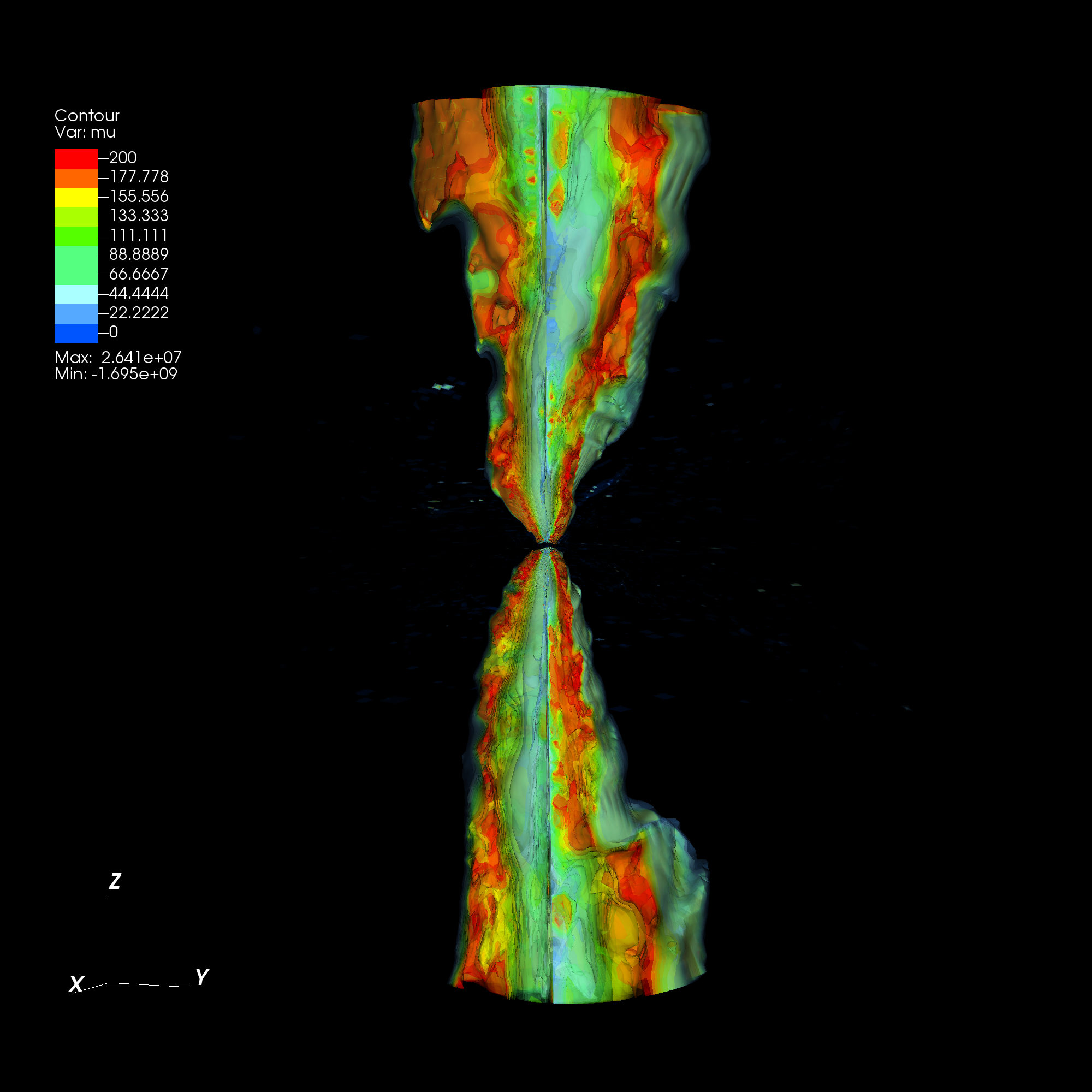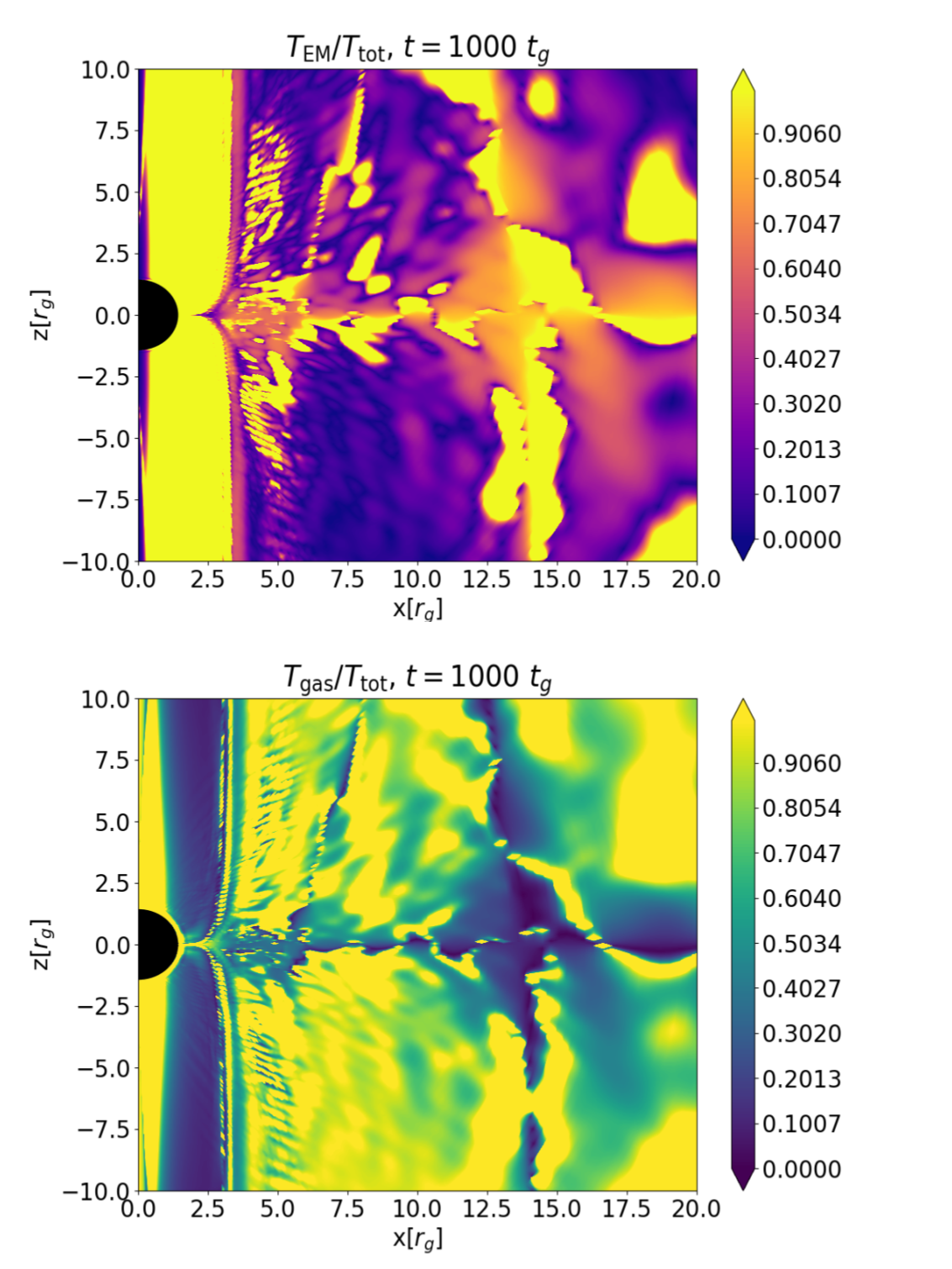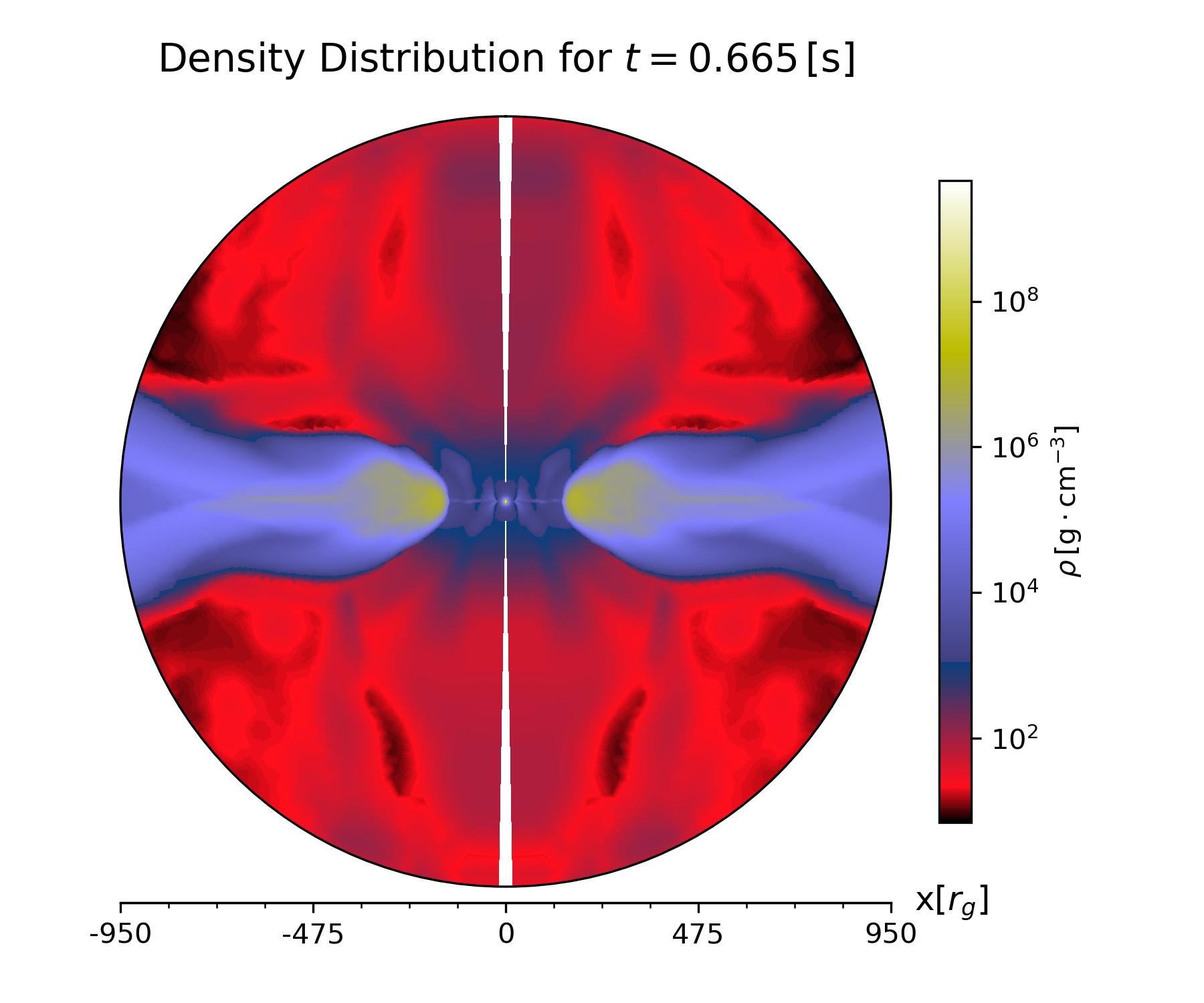
Postmerger Outflows from Magnetized Neutrino-cooled Tori
Kilonovae are transient emissions observed in the optical and near-infrared bands, powered by the radioactive decay of r-process elements synthesized in the aftermath of binary neutron star (NSNS) or black hole-neutron star (BHNS) mergers. These emissions arise from two sources: fast, neutron-rich tidal ejecta from the merger and moderate-velocity winds from the post-merger accretion disk. Our research focuses on the latter, using the GRMHD HARM-COOL code to model magnetized black hole-accretion disk systems.
We find that these winds, with velocities of v/c ∼ 0.1 - 0.24 and a broad electron fraction range (Ye ∼ 0.01 - 0.5), play a crucial role in shaping the surrounding cocoon and collimating relativistic jets. By varying parameters such as disk mass, black hole spin, and jet luminosity, we demonstrate that higher-mass disks and rapid spins produce faster, more massive, and neutron-rich outflows.
This work provides essential insights into the connection between accretion disk winds and the observable signatures of kilonovae, contributing to our understanding of multi-messenger events.
Figure shows The wind and jet structure in short GRB engines with compact object progenitors. Jet is modeled by MEZCAL simulations, with winde re-mapped with HARM_COOL data, postprocessed by nuclear reaction network (G. Urrutia et al 2024): Bottom panel: Snapshot of the outflow distribution. The values for pressure and electron fraction Ye were determined through the r-process.

Structure and Time Variability of Jets from Accreting Black Hole Sources
Variable accretion flows are a common phenomena in astrophysical black hole sources. Such sources are found at different mass scales, from the cores of active galactic nuclei, e.g. in radio loud objects such as blazars, to gamma ray bursts. Both the gamma-ray bursts and blazars often have a relativistic jet pointing towards or at a small angle from our line of sight. In such sources, the variability of the inflow can be transmitted to the properties of outflows. Observational studies have shown correlations between the observed jet variability time-scales and Lorentz factor of the emitted jet.
Motivated by these observational properties, we investigate the relation between the central engine properties and the variability of the jet outflows by means of numerical general relativistic magnetohydrodynamic (GRMHD) simulations. We perform axisymmetric 2D simulations as well as non-axisymmetric 3D simulations of the evolution of a central engine composed of a magnetized torus around a Kerr black hole that results in the launching of a non-uniform jet.
The simulations are performed in a general relativistic framework. We probe the jet energetics at chosen locations along the jet direction and we measure the jet time variability. Thus we try to understand the time variability properties of the jet emission by comparing our results with the observations. We also investigate the angular distribution profile of such jets as they have a more complex structure than a simple top hat. These studies are relevant in the better understanding of jet emission observed in gamma-ray bursts as well as in active galactic nuclei since we are able to scale our results with the black hole mass.
See Figure for the 3D jet structure from one of our models represented by the contours of jet energetics parameter at an evolved time of the simulation (James et al. 2022).
Jet launching mechanisms studies using BHAC code simulations
Our research focuses on jet formation mechanisms in collapsars and binary mergers using the BHAC code. For collapsars, we investigate jet launching in stripped-envelope massive stars, the progenitors of long GRBs. Stellar profiles evolved with the MESA code are remapped into BHAC, incorporating dipole-like magnetic fields and rotation in a Kerr spacetime with a defined spin . Magnetization and accretion near the black hole trigger the Blandford-Znajek process, facilitating jet formation and evolution through the star's structure.
For binary mergers, we explore magnetized disks and jet interactions within the merger remnant. Adaptive mesh refinement (AMR) in BHAC allows us to model the inner regions with high resolution, capturing the role of magnetic fields in launching and sustaining relativistic jets. These simulations provide insights into jet propagation and dynamics, essential for understanding the observed signatures of short GRBs.
Figure: Top Panel: illustration of a numerical grid with an adaptive mesh, used in the code BHAC with a result of one of our testing simulations for stellar collapse. Bottom Panel: BHAC simulations of jet formation in a collapsar, capturing the evolution of the dense stellar core, the magnetization growth near the black hole horizon, and the subsequent jet propagation. The visualizations highlight key phases, from the rapid accretion and Blandford-Znajek-driven jet launching to the expansion of the jet as it breaks through the stellar envelope.
--- Simulation Video ---


Effects of Magnetized AGN Accretion Disks on EMRI Gravitational Waves
The presence of magnetized accretion disks around supermassive black holes (SMBHs) can significantly impact the gravitational wave (GW) signals emitted by extreme mass ratio inspirals (EMRIs), where a smaller compact object orbits the SMBH.
Using the GRMHD code HARM-COOL, we conducted 2D and 3D simulations of weakly magnetized thin accretion disks to study their turbulence, effective viscosity, and interaction with the orbiting secondary black hole.
Our results reveal that viscous torques from the disk, driven by magnetorotational instability (MRI), can contribute up to 1% of the GW torque, introducing a measurable phase shift of approximately 10 radians in the GW signal over 106 orbits.
This highlights the significant influence of the accretion disk environment on GW signals, which could be detected by future interferometers like LISA.
These findings offer a unique window into the dynamics of accretion disks and their role in shaping multi-messenger astrophysical phenomena.
See Figure for 3D simulation of the thin disk around SMBH. Top: density and magnetic fields in the poloidal cut. Bottom: equatorial cut with the same quantities.
Black hole outflows initiated by accretion of large-scale magnetic field
We study black hole outflows driven by the accretion of large-scale magnetic fields, focusing on equatorial outflows in magnetized plasma around a black hole.
Using simulations in a fixed Kerr metric, we explore the evolution of plasma flows under varying black hole spin and magnetic field strength.
Our results show the formation of intermittent equatorial outflows that eject material along the equatorial plane, while some plasma escapes vertically.
The geometry of the flows near the event horizon is strongly influenced by the black hole spin, whereas the large-scale flow structure depends on the initial inclination of the magnetic field.
These outflows provide insights into the dynamics of weakly active AGNs and may help explain features observed in systems like M87*, where inflows and outflows coexist at different radii.
This research highlights the crucial role of large-scale magnetic fields in driving complex outflow patterns in black hole accretion systems.
Figure: The energy composition of developed outflows in a 2D model reveals the ratio of matter and electromagnetic energy to the total energy at a time instance of 1000 tg.
Initially, the system is organized, but turbulence dominates as evolution progresses. While large-scale structures persist in the equatorial plane and along the axis, a well-defined jet does not form in this simulation.
This highlights the complex interplay between matter and electromagnetic forces in shaping outflows.


Quasi-periodic X-ray eruptions (QPE) Modelling
Quasi-Periodic eruptions (QPE’s) are luminous bursts of soft X-rays from the nuclei of galaxies, repeating on timescales of hours to weeks.
The mechanism behind these rare systems is uncertain, but most theories involve accretion disks around supermassive black holes (SMBHs) undergoing
instabilities, or interacting with a stellar object in a close orbit, that results in a tidal disruption of a star.
We build the theoretical models for accretion disk thermal-viscous instablity cycles, which are driven by dominant radiation pressure.
Such instabilities may occur in the inner regions of the accretion diks, close to its marginally stable orbit around a black hole,
and operate over all mass range of black holes, from stellar mass sources in Galactic X-ray binaries, up to SMBHs.
Figure: Top Panel: X-ray observations by Swift and NICER of the QPE source AT2020ocn. from Pasham et al. (2024);
Bottom Panel: Accretion disk lightcurve from model assuming black hole mass of 10^5 Solar masses, size of 50 Schwarzschild radii, and magnetically heated corona
(here magnetic flux is about 0.22 of the total generated flux, and depending on the local accretion rate). Plot from Śniegowska et al. (2023), caculation with GLADIS code.
Teaching Activities in Our Group
Summer 2024 Internship Program
In Summer 2024, We supervised a student project at the University of Warsaw as part of our internship program:
- Piotr Płonka: Studied 2D and 3D accretion models with self-gravity to determine its influence on the formation of self-gravitating structures. Designed and improved a precise visualization system to assist in identifying these structures.
Summer 2023 Internship Program
In Summer 2023, Gerardo Urrutia supervised a student project at the University of Warsaw as part of our internship program:
- Jakub Trzaska: Focused on enhancing the visualization of Gamma Ray Burst (GRB) jet simulations, improving plot aesthetics and functionality in Python. The project involved analyzing tracer particles from simulations and refining visualization workflows using VisIt and integrated Python-Bash scripts.
--- Project Report ---
Summer 2022 Internship Program
On Summer 2022, our group members co-supervised four student projects at the University of Warsaw as part of our internship program:
- Adam Gonstal: Studied magnetized accretion disk simulations, focusing on post-merger outflow mass and energy budget.
- Jakub Szyndler: Investigated equilibrium torus solutions for barotropic fluids around Kerr black holes, verifying numerical accuracy in the poloidal loop configuration.
- Szymon Bójko: Analyzed gamma-ray burst signals observed by Swift satellite, finding correlations between decay parameters.
- Mateusz Kapusta: Investigated magnetic field structure and reconnections in magnetically dominated accretion disks.














